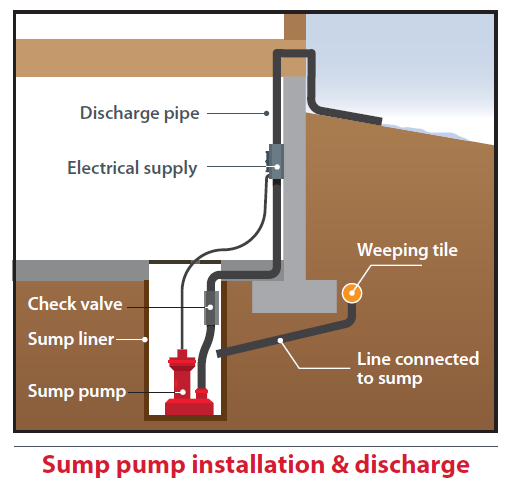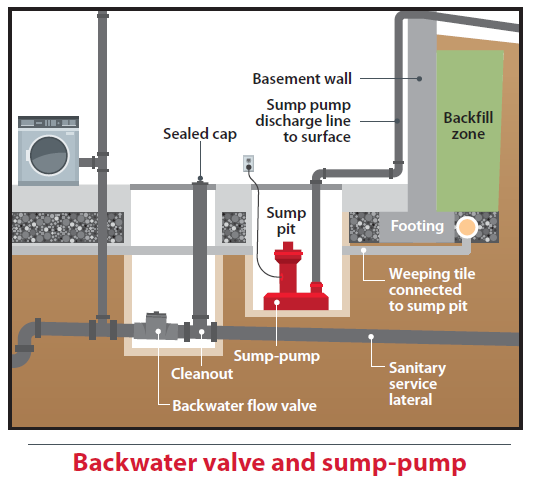Climate ready measures: Water management
Low water use appliances and fixtures
Climate change is expected to lead to longer, hotter and drier summers, meaning our water supply may face pressure in future decades.
By using low water use fixtures which are designed to use less water while maintaining the same level of performance, we can reduce our vulnerability to drought-like conditions.
Install low flow water showerheads and faucets in your home and replace your toilet with a low water use toilet when it is time for replacement.
The City of Calgary’s Water Utility Bylaw and the National Plumbing Code of Canada requires all renovations that require a plumbing permit to have low water use fixtures in place.
See the Calgary Homeowner Plumbing Guide for more details on low water use and fixtures.
Sump Pump
Some homes have a collection basin in the lowest part of a basement floor, called a ‘sump’. A sump pump discharges water from the foundation when it is not possible to drain your foundation directly into a municipal sewer.
If your home does not have a sump pump, and you do not have moisture issues in your basement, it is unlikely you need one. If you have a sump pump, consider the following:
- If it cycles frequently (e.g., daily or more frequently), you may be at high risk of flooding from pump failure. Consider installing a separate backup pump that triggers if the primary pump fails.
- All sump pumps should have a backup power supply installed. Do not use potable-water powered backup pumps. Instead, use a backup generator or battery backup system.
- Make sure a check valve is installed on the discharge pipe to prevent recycling of pumped water.
- Discharged water should clear the backfill zone of your foundation. If not, you may be recycling pumped water.
- Install a moisture alarm in the sump that detects water level rising to a critical level. Some types of alarms will alert smartphones. The alarm should also be set to trigger when the primary pump fails to engage.
- Ensure the sump lid has an airtight seal to prevent the ingress of Radon gas.
- Inspect and maintain your sump pump to ensure it is properly draining. You can do this by pouring water into the sump pit and seeing whether or not the pump starts automatically.
- Replace your pump every 10 years, or sooner.
Find more information about basement flooding, including sump pump tips.

Back-flow Prevention Device
To help prevent sewage from entering your basement, locate your property’s floor drain, clean-out sewer link and back-flow prevention device (backwater valve). Not every home has a back-flow prevention device. If you do not, consider installing one on your sewer pipe, or on basement showers, toilets and sinks.
Contact the Planning Services Centre to find out if your home requires a back-flow prevention device, and for additional questions about plumbing requirements.
To help prevent sewage from entering your basement:
- Install a back-flow prevention device (backwater valve) on your sewer pipe, or on basement showers, toilets and sinks.
- Locate your property’s floor drain, clean-out sewer line and back-flow prevention device (not every home has a back-flow prevention device).
A plumbing permit is required to install a back-flow prevention device. For proper installation, the valve should be graded (sloped) down toward the municipal sewer (at least 2% grade, but more is better). To install a back-flow prevention device, contact a qualified plumber. If you have a back-flow prevention device installed in your home, ensure it is properly serviced and maintained.
Learn more about preparing for a flood, and what to do if you do experience a sewage backup.
If you live in an area at risk of river flooding (see Calgary’s flood hazard map), or in close proximity to the Bow River, Elbow River, Nose Creek, or West Nose Creek, a back-flow prevention device may need to be installed in your home. Refer to the Land Use Bylaw (Part 3 Division 3) to learn when one is required.

Weeping tiles
Weeping tile is a perforated pipe that runs around basement foundations to drain high groundwater. For weeping tile systems that are directly connected to the storm water system, a weeping tile backup prevention device may lessen the flow of water from entering basements when the storm sewer system overloads.
If you experience basement flooding, visit The City of Calgary’s Basement Flooding and Seepage webpage.
If you live in a flood area, in accordance with the Calgary Land Use Bylaw, your electrical and mechanical equipment may need to be located at or above the designated flood level. If you don’t live in a flood area, this is also a good idea, if you have the option and space to do so.

